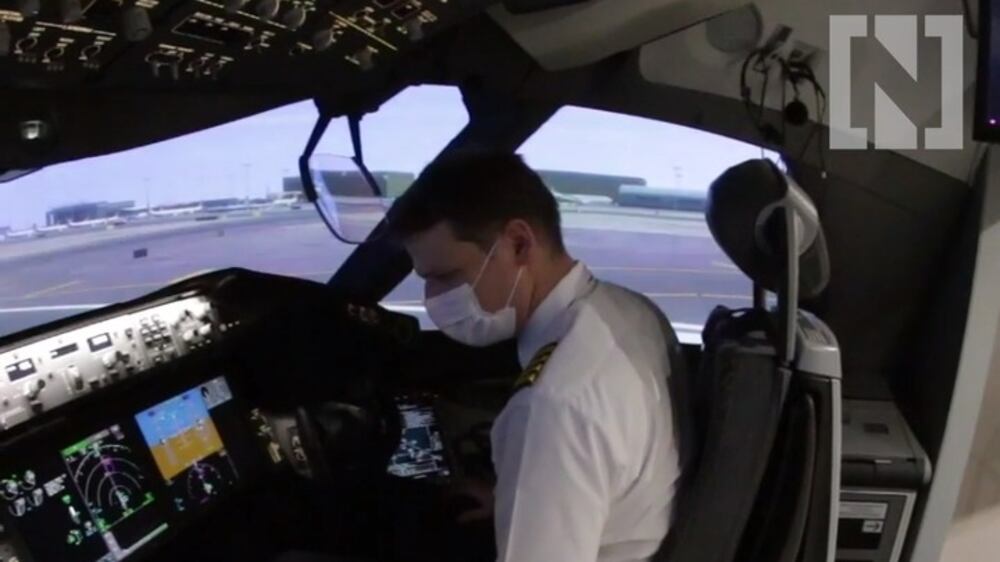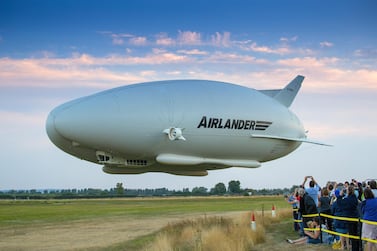It's been more than a year since the onset of the global pandemic and a time when travelling freely from one country to another was common.
Nowadays, travel restrictions, quarantine measures and lockdowns mean that booking a holiday based purely on where you want to go is a thing of the past. Instead, travellers must first check their eligibility to visit a country, PCR-testing policies and vaccination requirements for any destination.
But there is still one place in Abu Dhabi from where you can fly to any destination in the world, no tests, paperwork or other pre-departure testing necessary. I'm referring to Etihad Aviation Training, where pilots for the UAE’s national airline are trained to fly jets of all shapes and sizes.
After being grounded in Abu Dhabi for well more than a year, I went along to find out what it's like to fly a plane from Abu Dhabi to the Maldives, and to hopefully satiate some of my ever-growing wanderlust.
Million-dollar machines
Etihad Aviation Training is a sprawling building in the UAE capital that is home to 10 top-of-the-range flight simulators. From a Boeing 787 to an Airbus 380, Etihad Airways's range of simulator machines make it one of the best-equipped aviation training facilities in the world, and other airlines often come here to train their pilots.
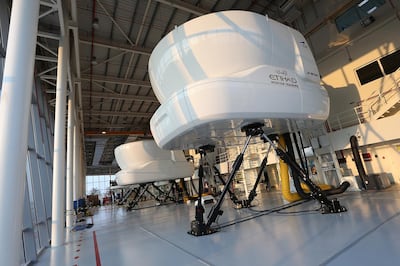
The high-tech facility does not come cheap. "It costs between $15 and $20 million" for a single simulator, says Captain Stefan Dudda, head of training at Etihad Aviation Training. And that's before you add on upkeep costs.
The machines are sourced from a company called CAE, based in Canada, and are specially manufactured for Etihad under licence from Boeing and Airbus. Every time an aircraft has an update in the real-world, the simulators need to be updated to reflect it, so it's a never-ending cycle of maintenance and care.
Etihad pilots are put through their paces at Etihad Aviation Training and the rigorous programme ensures nothing is left to chance. From practising flying through a thunderstorm, to simulating the loss of an engine mid-flight, pilots must complete refresher training every six months. Cadet pilots spend at least 160 hours in the simulator before being allowed anywhere near a real jet, which is decidedly reassuring to hear as a frequent Etihad passenger.
But today, I'm more than that. Crossing the ramp to the inside of the Etihad Boeing 787 simulator accompanied by Etihad's Captain Soren Rohwer, I'm getting set to fly this jet from Abu Dhabi to Velana International Airport in the Maldives.
Settling into the captain’s chair, with Rohwer as my co-pilot, I'm instantly overwhelmed by the endless rows of buttons, switches and instrument panels around me. It would take an age to decipher what each of them is used for – which helps explain why pilot training is so intense – but for our purposes, Rohwer explains the most important ones I'll need to know about.
Both the pilot and co-pilot have a set of these critical controls on all Boeing Dreamliner flights. They include the yoke – which is essentially the jet’s steering wheel; the thrust levers – to provide power to the engine; and the primary flight display that records speed, indication and altitude.
A navigation display gives a continuous overview of the route we are going to fly, meaning that even if there is thick fog outside – a scenario that is later simulated for us – pilots can continue flying by following their instruments.
Wheels up for take-off
Having heard a "cleared for take-off" announcement from Dudda, I realise it's time to go. Releasing the parking brake with the foot pedals, I take hold of the thrust levers and advance them slowly forward and we begin to move down the simulation of the runway of Abu Dhabi International Airport.
Picking up pace until I reach a rotation speed of 305 kilometres per hour, I'm told to pull back on the yoke that raises the jet's nose in the air. It takes a decent amount of energy to complete this task, but as I pull, the aircraft simultaneously takes off and that's it – we're flying.
The scenery outside the cockpit is deceivingly realistic and it's hard not to feel like I've actually been put in charge of a multimillion dollar aircraft – quite a scary thought for a less-than-rookie pilot.
Flying through thunderstorms and fog
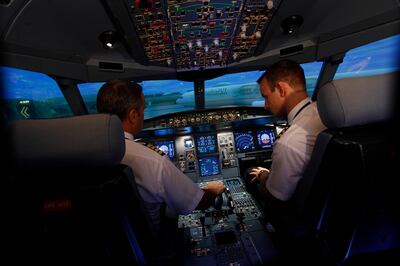
Cruising to 10,000 feet, I engage autopilot and being to relax again. Like all pilots working at Etihad Aviation Training, Rohwer is also an operational member of the flying crew – meaning that he continues to fly jets to destinations around the world and operate real-life flights, not simply simulated ones.
He wanted to be a pilot since he first saw a flight deck aged 8 years old, and now Rowher has been flying for more than 13 years, eight of them with Etihad.
My attention is suddenly caught by a purple swell on the jet's navigation panel, which turns out to be a scary-looking thunderstorm. Under Rohwer’s calm instructions, I turn the jet to the left, gliding directly past the storm without any drama. This technique is exactly how Etihad pilots are trained to handle a real-life thunderstorm, avoiding flying through the eye of it at all costs.
"In these full flight simulators we're training real-life situations that could occur anywhere during the line operation in emergency, abnormal and normal operations, of course, like flying around in thunderstorms and any adverse conditions that you could imagine in normal operations," explains Dudda.
"And then, of course, the abnormal operations, things that we all hope will never happen to us in real flights," he says.
A bumpy landing in the Maldives
It’s soon time to prepare for a descent in the Maldives – the simulators can run on real-time, but pilots typically do not sit in the machines for the same amount of flying time that it would take to go between destinations, focusing instead on practicing take-offs, landings and other simulated incidents.
Outside the cockpit, the scenery has changed and I feel like I really am soaring above the Maldives, thanks to endless turquoise waters and the sandy archipelagos stretched in front of me. The imaging is widely accurate, right down to the scale of the surroundings on approach to each airport. This is so that pilots can get a taste for landing at various airfields around the world.
"Airports are categorised into A, B and C – the A airfields are relatively easy to fly in to, category B airfields have a small challenge to them, such as Johannesburg in South Africa due to its high elevation above sea level; this makes flying more challenging as the air is less dense.
"Category C is an airfield that is very challenging and a high-risk environment," explains Dudda, who has been with Etihad for 17 years.
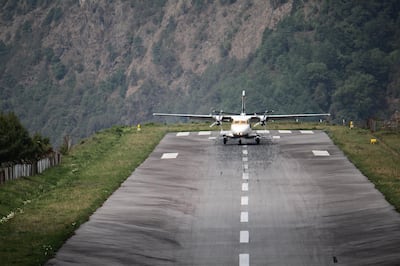
"Katmandu in Nepal is a category C. This airfield is located deep down in a valley, surrounded by the highest obstacles on our planet – the Himalayas. Any pilot wanting to land in Katmandu must train normal and abnormal operations in a simulator before their first operational flight there."
Thankfully, Velana International Airport is ranked as a category A airfield, so I get set to put our wheels down.
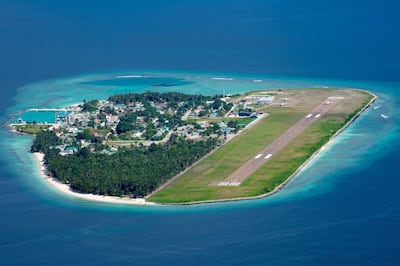
Flying towards a runway at more than 300kph, it's a surreal feeling to think that I'm going to try to set a 250,000-kilograms jet on the tarmac. I need to remind myself more than once that I'm not actually going to land the Dreamliner, which is lucky as my first attempt at landing is a definite crash.
Thankfully, in the world of simulated flight, there's no harm done and we reload the system to show Abu Dhabi International Airport, another category A airfield, and where I'll attempt landing number two.
A shift in scenery shows the bright red roof of Ferrari World below me and I can pick out Yas Mall, the F1 Grand Prix track and the waters of the Arabian Gulf. The "clear to land" announcement rings through the speakers and I take a deep breath as I get set to touch down.
This time, as Rohwer reminds me to use "smooth, steady movements", I feel a little more in control. Closing in on the tarmac, I manage to keep the jet on-course and as the runway creeps ever closer, I pull gently on the yoke, slowing the jet's descent and putting wheels down in a landing that, according to my expert co-pilot, is "actually alright".
